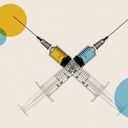We still don't know how the novel coronavirus pandemic began

A World Health Organization team is beginning a long-delayed investigation in China into how SARS-CoV-2 emerged, as a theory about a possible lab accident is raised in a major magazine.
Why it matters: Understanding the origins of COVID-19 is vital if we're going to prevent the next pandemic.
Driving the news: A year after the first COVID-19 cases were reported in China, a team of 10 international scientists under the auspices of the WHO is set to investigate the origins of the outbreak in the city of Wuhan.
- The investigation will likely focus on fleshing out the prevailing theory of how the outbreak began: a bat coronavirus that somehow made its way to human beings in an example of zoonotic spillover.
The other side: But in a 12,000-word story published yesterday in New York magazine, the writer Nicholson Baker argued COVID-19 "was an accident."
- Baker wrote it is possible, and even probable in his view, that what became SARS-CoV-2 "was made more infectious in one or more laboratories" through what is known as "gain of function" research, and somehow escaped into the wild.
Reality check: While Baker noted suspicious circumstances — like the fact that Wuhan is the only Chinese city that has a maximum security biosafety lab, where work had been done in the past on bat coronaviruses — there is little conclusive evidence in the piece that the virus originated in a lab.
- "This article is filled with wild speculation about SARS-CoV-2's origins and signifies a lack of understanding around basic genetics and viral evolution," tweeted Nsikan Akpan, a pathobiologist and health and science editor at the radio station WNYC.
Yes, but: Speculation aside, there are still major questions about how COVID-19 emerged.
- An AP investigation last week found Beijing has heavily censored research into origins of SARS-CoV-2, even as Chinese state media has pushed theories that the virus first emerged overseas.
The big picture: Baker is right to note the growing risk posed by gain of function experiments that involve creating new, more virulent or contagious strains of existing viruses in the lab in an effort to predict and prepare for future pandemics.
- Lab accidents are rare, but they do occur — and as modifying viruses becomes easier and easier, the existential consequences of those accidents will grow.
Go deeper: The coronavirus pandemic reawakens bioweapons fears